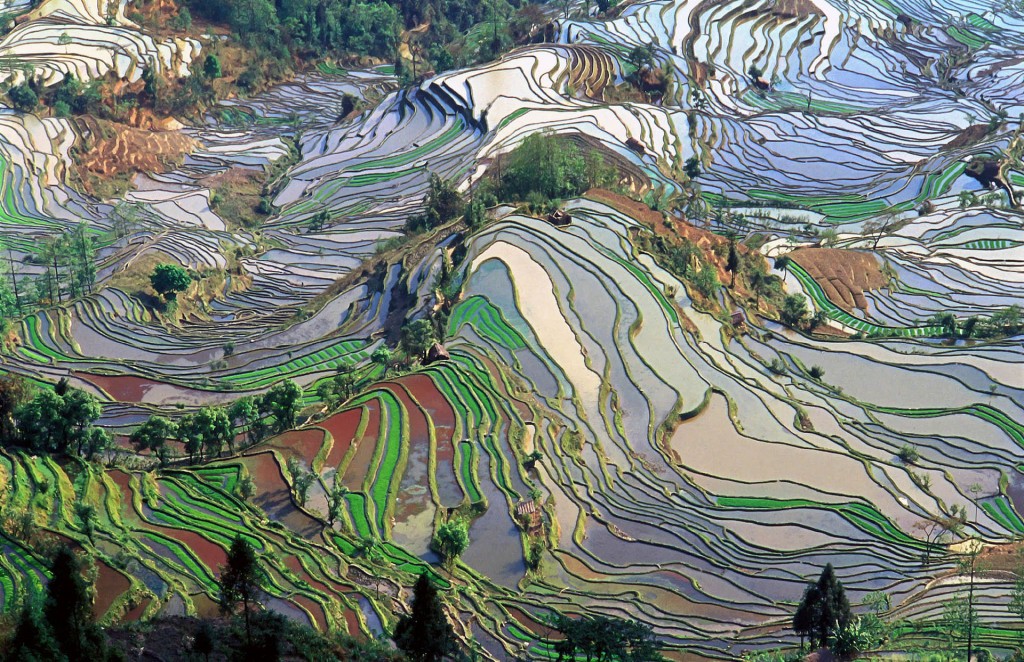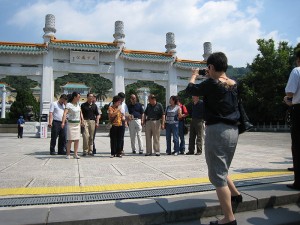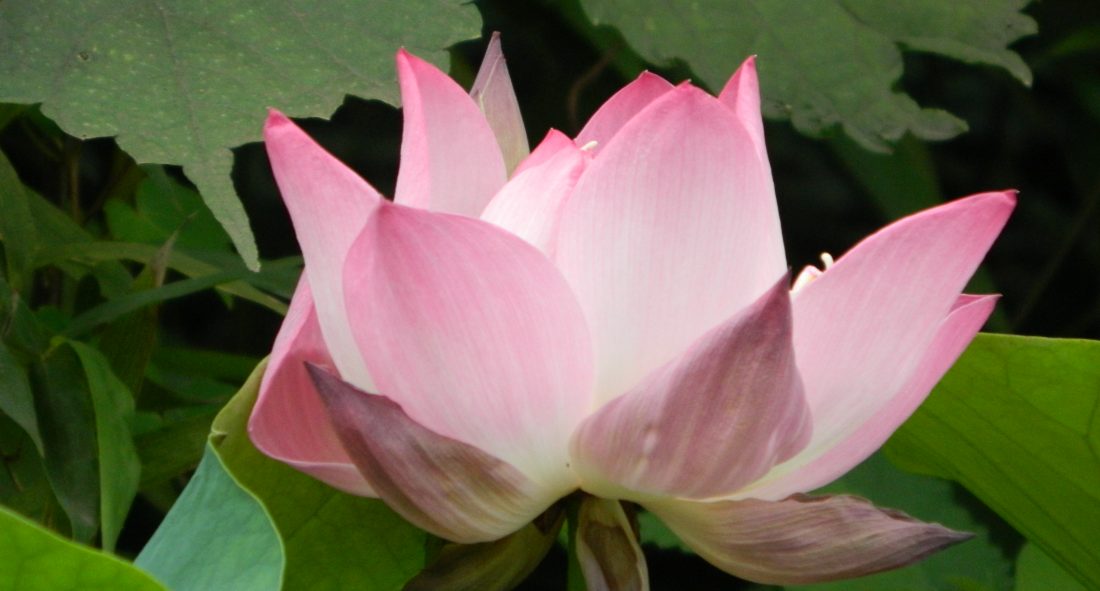By Thomas Stubbs, Connor Courtney, Christian Frabitore, Simone Alimonti, and Kate Stevens

Like the rest of China’s economy, the tourism industry is growing at an almost unimaginable rate. Travel was highly restricted for Chinese citizens until the mid-1980s, but since then it has become a form of leisure affordable for an ever-increasing number of people. For example, when Hong Kong was finally made open to mainland Chinese in 1997, soon they made up 75% of the island’s tourist population. Until the mid-2000s most Chinese tourists still traveled in big tour groups to keep their trips affordable, but since then independent tourism has become much more commonplace (Chan and Zakkour). Since more people have money and a desire to travel there has been a growth in tourism in the rural villages of China, as seen in one of our Chinese Environmental Film Festival Films, Peasant Family Happiness. The pumping of new economic life into these traditional agricultural villages would seem to be a positive occurrence. However, the conversion of an agricultural community into a tourist mecca comes with certain consequences.
In her book A Landscape of Travel, author and researcher Jenny Chio explains that the main reason why so many villages in China are embracing the tourist model is because the initial change is fairly easy. Villagers do not need to re-invent their simple homes and lifestyles; that is exactly what the tourists come to see. Those who head to the countryside on vacation are looking to immerse themselves into the simplicity of rural life as a tonic for the bustling, polluted cities in which they reside. Then, in theory, a village does not need to alter itself in order to give tourists the experience they are looking for. According to Chio, the industry is also of benefit to Chinese ethnic minorities, whose customs are given greater visibility through their inclusion in the entertainment industry presented to incoming tourists. This exposure fosters an awareness of and appreciation for those minorities’ cultural heritage never before seen in mainstream Chinese culture. However, Chio points out that the transition from agricultural town to tourism center is not so “clean cut (14).” Once a village establishes a successful tourism industry, it must inevitably divert further resources and people to feed its growth. That leads to the neglect of the very economic and cultural practices that the tourists have come to see. Left unchecked, this redirection of community resources can lead to the replacement of what Chio calls “visual spots”—the genuinely unique features of the community which draw tourists—with “representative spots,” artificial representations of those features which over time became too neglected to showcase. Thus, while the growth of rural tourism can have a positive effect on local culture (by keeping it alive and increasing public awareness), it can be detrimental to the very parts of that community which drew tourists there in the first place.

Looking beyond the cultural impact of rural tourism, the more pragmatic question to ask is whether or not it improves the lives of the villagers themselves. As we saw in Peasant Family Happiness, the villagers who were interviewed had positive things to say about how the development of tourism in their communities had changed their lives; an elderly woman noted that the aged members of the community no longer had to keep working in the fields, but instead could take more manageable jobs in town. However, as the towns that have fostered tourism have shown, the benefits to a community can be uneven and the overall effect destructive. When the town of Xijiang, located in the Guizhou Province, first broke into the tourist trade, the villagers were allocated 18% of the town admission ticket price. However, as time has passed, the residents of Xijiang have reaped the benefits of their tourist industry in an increasingly uneven manner says CNN reporter Katie Hunt. Shops and restaurants located at the center of town receive far more business than those on the outskirts, and the resulting competition has destroyed the sense of community and comradery which once existed in the village, according to Chief Tang Saucheng. Since there is now money to be had, money and the desire for economic gain has come to command people’s judgment as never before. Many parents in Xijiang want to become successful enough that their children will be able to stay in the village rather than migrate into the city, thus ensuring the community’s vitality for another generation. This shared desire, however, has led to cutthroat competition that has broken down the fabric of the community; most disturbingly, this development has been accepted by some as the only way for their society to move forward. “We want to preserve our way of life but progress is important too,” said Yang Zhou, who wants to find a way for his two children to grow up and stay in the village. Wang Hongguan, Director of the Guizhou Provincial Bureau of Cultural Heritage, notes that “The reason why these places failed is because of the desire for economic development — culture has become a commodity and people approach it in a degrading way” (Hunt).

Additional problems face villagers when their town is of such historic importance that the State gets involved. Qingkou Village in the Yuanyuang region is home to several historic “mushroom houses,” and the government pays the owners a certain amount of money to keep them in their historic condition. This seems like a fair arrangement; however, it turned out to be the first step towards curtailing the community’s involvement in its own affairs. Films are now shot in Qingkou that physically alter the town without community permission, and citizens are made to look and act a certain way in the name of preserving cultural heritage, turning the town into a “cultural theme park.” This provides the state with a new means of exerting control over the citizenry (Diekmann and Smith).
In the short time that rural tourism has been a viable industry, it has become a complex issue. There are many potential benefits; the good which comes from citizens of these rural villages being lifted out of poverty cannot be ignored. However, as an economic force, rural tourism is vulnerable to the effects of the same runaway excess found in other economic sectors of China. This might lead to the forced preservation of historic homes and sites, but can also have a toxic effect on the community itself, socially, culturally, and economically. If the industry is to grow in a healthy way, villagers must be very careful about maintaining the delicate balance of tourism in their communities; properly managed, it is possible for rural tourism to thrive without initiating community breakdown and tempting state control.

Further reading can be found in this wiki, this blog, and this journal.
Bibliography:
Chan, Savio; Zakkour, Michael. China’s Super Consumers: What 1 Billion Customers Want and How to Sell it to Them. Hoboken: Wiley, 2014. http://furman.eblib.com/patron/FullRecord.aspx?p=1780038 (accessed April 15, 2015).
Peasant Family Happiness. Berkeley Media, LLC, 2013. DVD.
Hunt, Katie. “As China’s Villages Vanish, One Pins Hopes on Tourism for Survival – CNN.com.” CNN. August 29, 2013. Accessed April 15, 2015. http://www.cnn.com/2013/08/29/world/asia/china-rural-tourism/.
Diekmann, Anya; Smith, Melanie Kay. Ethnic and Minority Cultures as Tourist Attractions. Clevedon: Channel View Publications, 2015. http://furman.eblib.com/patron/FullRecord.aspx?p=1920438 (accessed April 15, 2015)

I think those are nice picts, I hope oneday I can visit that place. Thanks for sharing
Great use of links and photos throughout! The captions are very descriptive and the photos add to the reader experience. I also love how you have a link to some further information. One suggestion: since the post is so long, I would suggest breaking it up into different sections with bolded headings so the reader doesn’t get lost in all the text.
Again a very interesting topic and a well write blog. Like we said in class the text wall is a little intimidating but the blog itself was an easy read and did a good job at covering the issue overall and not being biased. A suggestion would be to hyperlink more and if it is possible put a link up to the movie if it is easliey accessed online if not maybe even the trailer of it or something like that. To allow the reader to at least have some background on the movie. But I liked to topic and it is enjoyable to really be able to dive into issues like this because not many people think about it.We just commonly think that since they are doing this it has to be good or else they wouldn’t do it and as you found out sometimes it doesn’t always work out as well as we think. Also I like that you included a further reading tab at the end.
Hi guys,
Your blog post is really excellent; it is very informative without being dry or confusing. From a technical standpoint I would make the links to the pictures hyperlinks and also make the pictures hyperlinks to the sources themselves. Also, I know it is somewhat difficult to accomplish but I would suggest wrapping the text around the pictures to break up the fairly long paragraphs. Speaking of the photos, I really like the ones you chose as there are visually striking but also fit in nicely with the text. Some of you sources are not hyperlinked, and even though they might be articles or books it would be best to link to some page where the reader can find out more information on the source. I think it’s great that you used your film from the film festival as a starting off point for your post, which was a nice idea and probably gave you more background on the topic than most. Your sources seem informative, but it is a little blocky and makes the piece seem separated to only discuss one source per paragraph. It might be too much work to go back and integrate more, but you might want to add at least a little more connection between sources. If you are looking for an additional source, Country Driving seems like the obvious choice, as there was quite a bit of discussion on the growing tourism industry in small villages. Overall, this blog seems very carefully researched and written and I didn’t spot any other mistakes grammatically or content wise.
The tourism industry in China seems to be incredibly complex. The benefits and negatives seem to be at a constant war. I found it interesting that when the villagers had money at stake the sense of community was lost and capitalism was prominent. It’s also strange how people have to “act” in their daily lives in a cultural town. The expectations of them might hinder their progress or daily lives.